Vivicam 3735 User Manual
English
021014
�
digital camera
user’s manual
Warranty Policy
This camera is under warranty for one full year from the date of purchase by the original purchaser.
In case of defects in materials or workmanship, we will replace or repair the camera free of
charge. This warranty applies to the camera only. This warranty does not include batteries, or
other accessories which have not been manufactured by our company. This warranty will not be
honored if the camera has been mishandled or tampered with, or altered by anyone other than
the manufacturer. Other than for the warranty herein, we are not responsible for loss, damage, or
inconvenience of any kind. A defective camera being returned under warranty must be
accompanied by a brief description of the difficulties encountered and also by a proof of purchase
with the date of purchase clearly indicated. All related transportation costs and insurances are at
the owner’s expense. Any alteration of this warranty cannot be made without the written approval
from our company.
FCC Notice
This equipment has been tested and found to comply with the limits for a Class B digital device,
pursuant to part 15 of the FCC Rules. These limits are designed to provide reasonable protection
against harmful interference in commercial installation. This equipment generates, uses and can
radiate radio frequency energy and if not installed and used in accordance with the instructions,
may cause harmful interference to radio communications. However, there is no guarantee that
interference will not occur in a particular installation. If this equipment does cause harmful
interference to radio or television reception, detectable by turning the equipment in question off
and on, the user is encouraged to try to correct the interference by one or more of the following
measures: Reorient or relocate the receiving antenna; Increase the distance between the
equipment and the receiver; Connect the equipment to an outlet on a different circuit than that
which the receiver is connected to; Or consult the dealer or an experienced radio/TV technician
for help.
NOTE
A shielded-type DC power cable incorporated with a ferrite core is required in order to meet the
FCC emission limits and also to prevent interference to the nearby radio and television reception.
Use only shielded I/O cable incorporated with a ferrite core to connect this equipment to host
computer and TV set. Shielded A.C. power cable and shielded I/O cables are required in order to
meet the FCC emission limits. It is essential that only the supplied power cord and I/O cable(s)
can be used.
2
�
WARNING
Do not use this camera if it is emitting smoke, becomes unusually hot to be touched,
emitting any unusual odor or noise, or if it is in any other abnormal states.
Operating the camera in any of these situations may cause a fire or an electrical shock.
Stop using the camera immediately, turn the camera off, and then disconnect the power
source (batteries or AC power adapter). (If you are using the AC power adapter, unplug the
adapter from the AC power outlet after you have disconnected the camera.)
After checking that smoke is no longer being emitted, contact your dealer or your local
authorized service facility and request repairs. Never attempt to repair this camera by yourself
as this is dangerous.
Do not use the camera if any water has entered the camera.
Turn the camera off, and then disconnect the power source (batteries or AC power adapter).
(if you are using the AC power adapter, unplug the adapter from the AC power outlet after
you have disconnected the camera.) Then contact your dealer or your local authorized
service facility.
Do not continue to use the camera as this may cause a fire or an electrical shock.
Do not use the camera if any foreign objects have entered the camera.
Turn the camera off, and then disconnect the power source (batteries or AC power adapter).
(if you are using the AC power adapter, unplug the adapter from the AC power outlet after
you have disconnected the camera.) Then contact your dealer or your local authorized
service facility.
Do not continue to use the camera as this may cause a fire or an electrical shock.
If the camera has been dropped or if the camera case has been damaged, turn the camera
off, and then disconnect the power source (batteries or AC power adapter). (if you are
using the AC power adapter, unplug the adapter from the AC power outlet after you have
disconnected the camera.) Then contact your dealer or your local authorized service facility.
Do not continue to use the camera as this may cause a fire or an electrical shock.
Do not place the camera in any unstable locations such as on a wobbly table or sloping
surface where the camera may fall or tip over and cause injury.
Do not expose the camera to moisture and make sure that there is no water getting into the
camera. Take particular care when using the camera under extreme weather conditions
such as rain or snow, or when operating the camera at the beach on near water.
Water in the camera may cause a fire or an electrical shock.
3
�
digital camera
user’s manual
WARNING
Do not insert or drop metallic or inflammable foreign objects into the camera through
access points such as the Compact Flash card slot.
This may cause a fire or an electrical shock.
Do not attempt to modify this camera.
This may cause a fire or an electrical shock.
Do not remove the camera casing.
This may cause an electrical shock.
Internal inspection, maintenance and repairs should only be carried out by your dealer or
local authorized service facility.
Avoid using this camera in the bathrooms.
Exposure to excessive moisture may cause a fire or an electrical shock.
Do not touch the power plug during a thunderstorm if you are using the AC power adapter.
This may cause an electrical shock.
Never operate this camera in any way while driving a vehicle.
This may cause a traffic accident.
4
�
CAUTION
Do not place this camera in damp or dusty locations.
This may cause a fire or an electrical shock.
Do not place this camera in a location affected by oil fumes or steam, such as near a
cooking stove or humidifier.
This may cause a fire or an electrical shock.
Do not leave this camera in a location subject to extremely high temperatures, such as in a
sealed vehicle or in direct sunlight.
Exposure to high temperatures may adversely affect the camera case and internal
components and may cause a fire.
Do not cover or wrap the camera or the AC power adapter with a cloth or quilt.
This may cause heat to build up and distort the case and cause a fire.
Always use the camera and its accessories in well-ventilated locations.
Handle the camera carefully and do not bump the camera into any hard object.
Handling the camera roughly may cause a malfunction.
Do not move the camera while it is switched on.
(if you are using the AC power adapter, unplug the adapter from the AC power outlet after
you have switched off the camera.) Ensure that any connector cords or cables to other
devices are disconnected before moving the camera.
Failure to do so may damage the cords or cables and cause a fire or an electrical shock.
When handling the camera, always unplug it from the power source (batteries or AC power
adapter) for safety.
(if you are using the AC power adapter, unplug the adapter from the AC power outlet after
you have disconnected the camera.)
Failure to do so may result in an electrical shock.
When leaving the camera unused for long periods, such as during a vacation, always
unplug the camera from the power source (batteries or AC power adapter ) for safety.
(if you are using the AC power adapter, unplug the adapter from the AC power outlet after
you have disconnected camera.)
Failure to do so could result in a fire.
5
�
digital camera
user’s manual
CAUTION
Do not use batteries other than those specified for use with your camera.
The use of unsuitable batteries may result in the batteries splitting or leaking and causing
a fire, injury, or soiling of the battery compartment.
When fitting batteries into the camera, check the polarity markings on the battery ( - and
+ )to ensure that battery correctly.
Incorrect battery polarity may result in the batteries splitting or leaking and causing a fire,
injury, or soiling of the battery compartment.
Remove the batteries if the camera will not be used for an extended period of time.
The batteries may leak and cause a fire, injury or soiling of the battery compartment.
If the batteries leak, clean and wipe the battery compartment carefully and install new
batteries.
Wash your hands carefully if you touch the battery fluid.
6
�
Table of Contents
Introduction
Preparing the camera
Getting to know the camera
Front View
Top View
Back View
Bottom View
Side View
Dial Knob
Zoom Lever
Menu Controller
Voice Memo Button
View Angle Adjustment Knob
Status LCD
Attaching the Strap
Preparing Power Supply
Loading Batteries
Using the Power Adapter
Inserting/Removing the Compact Flash Card
Inserting a Compact Flash Card
Removing a Compact Flash Card
Getting Started
Turning the Camera On and Off
Checking Batteries
Turning the LCD Monitor On and Off
Adjusting the Menu Display Language and Time/Date
Formatting the Compact Flash Card
Internal Memory/CF Card Full
Navigating through Menus
Using Menus When Taking Pictures
Using Menus When Viewing Pictures
How to Change Settings
10
11
11
11
11
11
12
12
12
12
12
13
13
13
14
14
14
14
15
15
16
17
17
17
17
18
18
19
19
19
19
20
7
�
digital camera
user’s manual
21
21
22
22
22
22
23
23
24
24
25
26
27
27
27
27
28
28
29
29
29
30
30
30
30
30
31
31
32
33
33
33
34
34
35
35
35
Taking Pictures
Taking Single Pictures
Taking Distant/Close-up Pictures
Zoom Control
Optical Zoom
Digital Zoom
Focus Lock
Taking Sports Pictures
Taking Burst Pictures
Using the Flash
Using the Self-Timer
Voice Memo
Camera Settings
The Picture Menu
ISO (Sensitivity)
Exposure Compensation
White Balance
Picture Resolution and Quality
The Camera Menu
LCD
Auto Review
Self-Timer
The Setup Menu
Advanced
Language
Set Clock
Auto Off
Sounds
LCD
Viewing, Copying and Printing
Viewing Single Pictures
Choosing Information to Display on LCD Monitor
Magnifying Pictures
Displaying Pictures in Thumbnail View
Erasing Pictures
Erasing Single Pictures
Erasing All Pictures
8
�
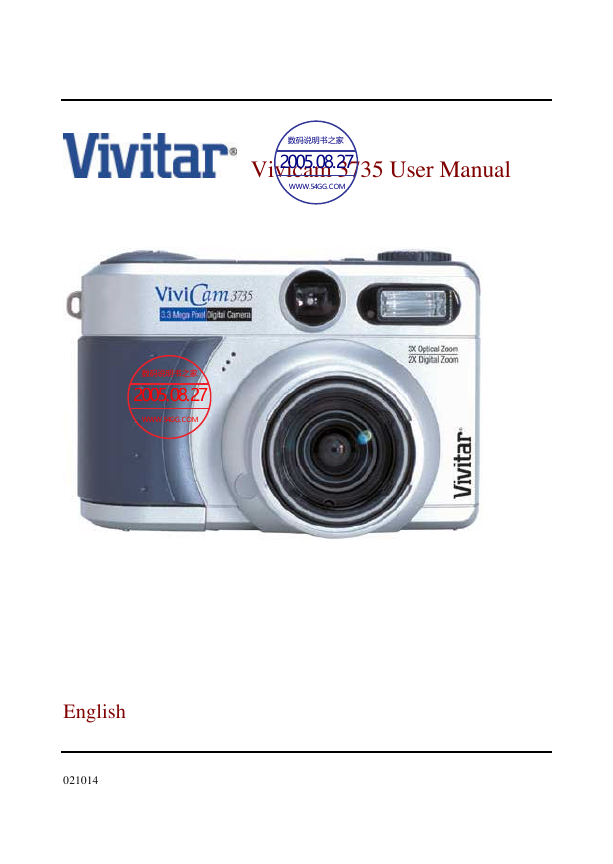
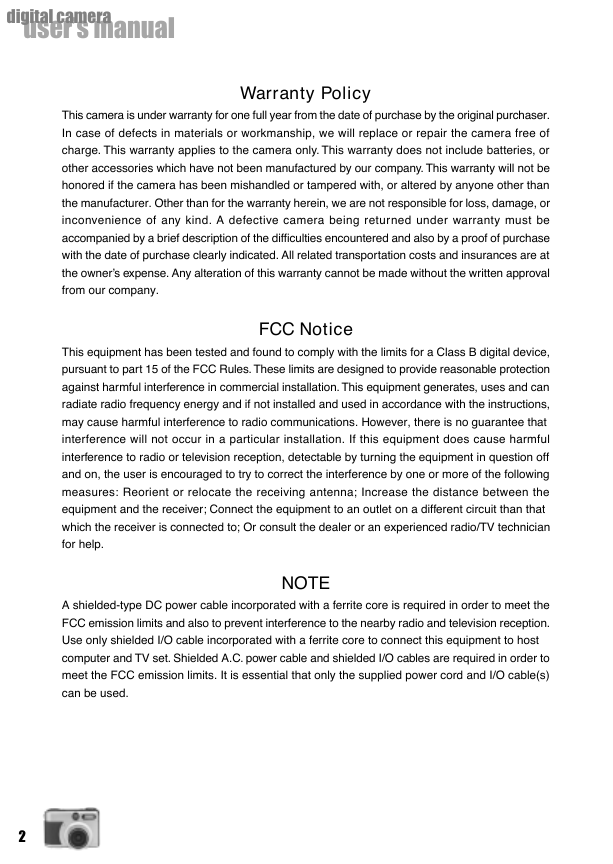
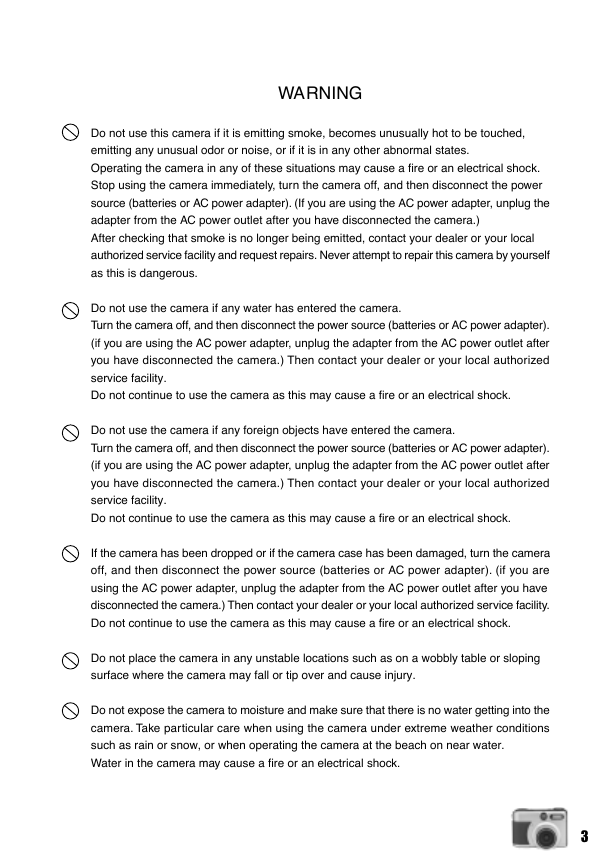
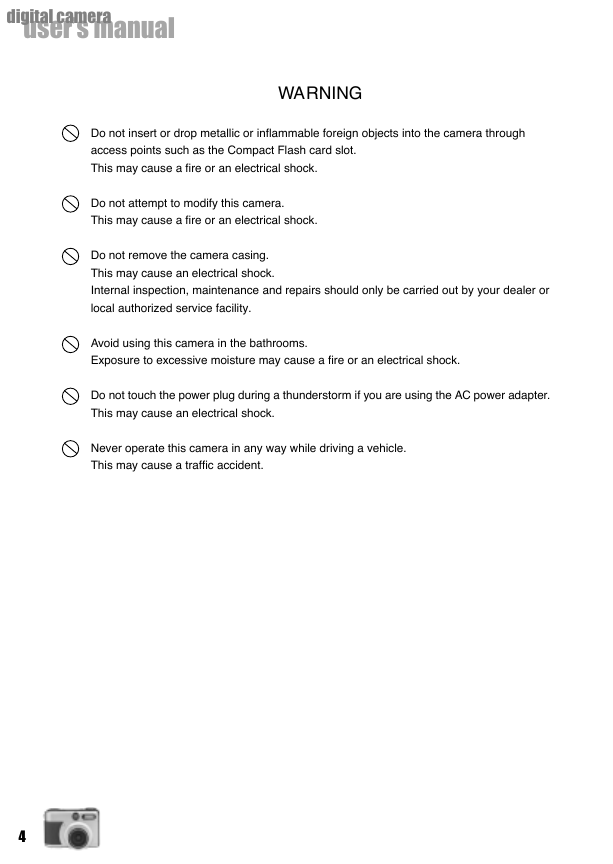
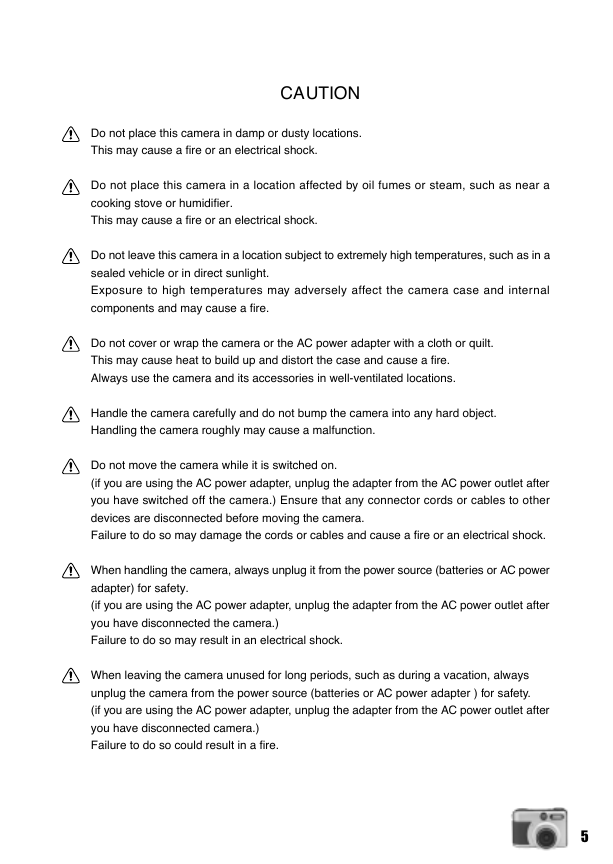

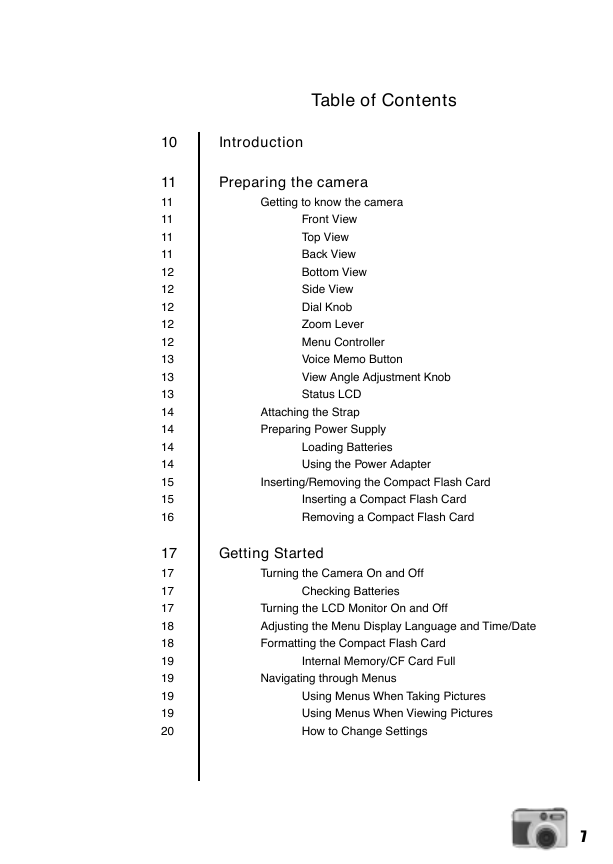
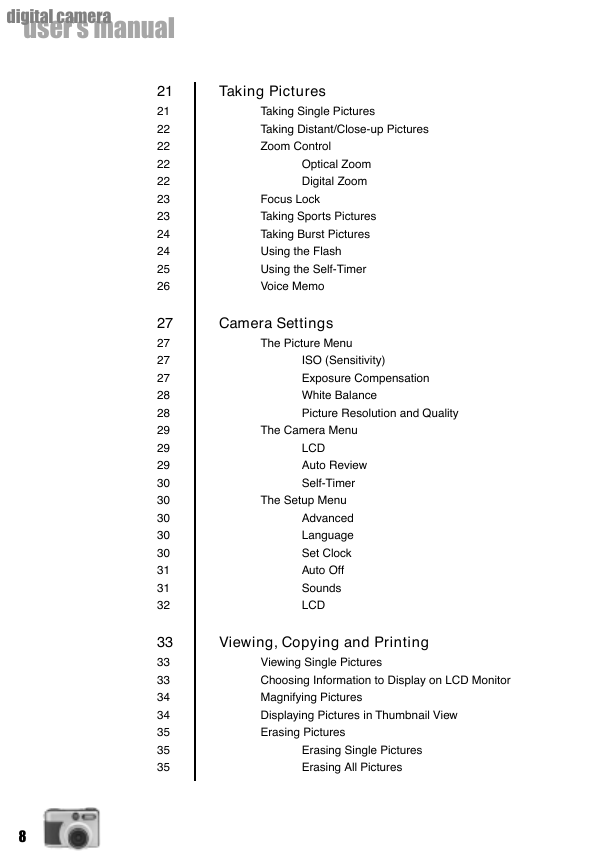








 2023年江西萍乡中考道德与法治真题及答案.doc
2023年江西萍乡中考道德与法治真题及答案.doc 2012年重庆南川中考生物真题及答案.doc
2012年重庆南川中考生物真题及答案.doc 2013年江西师范大学地理学综合及文艺理论基础考研真题.doc
2013年江西师范大学地理学综合及文艺理论基础考研真题.doc 2020年四川甘孜小升初语文真题及答案I卷.doc
2020年四川甘孜小升初语文真题及答案I卷.doc 2020年注册岩土工程师专业基础考试真题及答案.doc
2020年注册岩土工程师专业基础考试真题及答案.doc 2023-2024学年福建省厦门市九年级上学期数学月考试题及答案.doc
2023-2024学年福建省厦门市九年级上学期数学月考试题及答案.doc 2021-2022学年辽宁省沈阳市大东区九年级上学期语文期末试题及答案.doc
2021-2022学年辽宁省沈阳市大东区九年级上学期语文期末试题及答案.doc 2022-2023学年北京东城区初三第一学期物理期末试卷及答案.doc
2022-2023学年北京东城区初三第一学期物理期末试卷及答案.doc 2018上半年江西教师资格初中地理学科知识与教学能力真题及答案.doc
2018上半年江西教师资格初中地理学科知识与教学能力真题及答案.doc 2012年河北国家公务员申论考试真题及答案-省级.doc
2012年河北国家公务员申论考试真题及答案-省级.doc 2020-2021学年江苏省扬州市江都区邵樊片九年级上学期数学第一次质量检测试题及答案.doc
2020-2021学年江苏省扬州市江都区邵樊片九年级上学期数学第一次质量检测试题及答案.doc 2022下半年黑龙江教师资格证中学综合素质真题及答案.doc
2022下半年黑龙江教师资格证中学综合素质真题及答案.doc